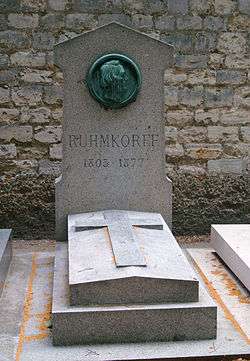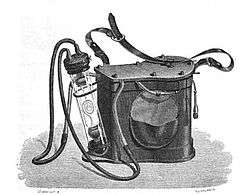Heinrich Daniel Ruhmkorff


Heinrich Daniel Ruhmkorff (Rühmkorff) (January 15, 1803 in Hanover – December 19, 1877 in Paris) was a German instrument maker who commercialised the induction coil (often referred to as the Ruhmkorff coil.)
Ruhmkorff was born in Hanover. He changed the "ü" to "u" in his name when living abroad. After an apprenticeship with a German mechanic, he moved to England. Biographies say that he worked with the inventor Joseph Bramah, but this is unlikely since Bramah died in 1814. He may, though, have worked for the Bramah company. In 1855, he set up a shop in Paris, where he gained a reputation for the high quality of his electrical apparatus.
Although Ruhmkorff is often credited with the invention of the induction coil, it was in fact invented by Nicholas Callan in 1836. Ruhmkorff's first coil, which he patented in 1851, utilized long windings of copper wire to achieve a spark of approximately 2 inches (50 mm) in length. In 1857, after examining a greatly improved version made by an American inventor, Edward Samuel Ritchie,[1][2] Ruhmkorff improved his design (as did other engineers), using glass insulation and other innovations to allow the production of sparks more than 30 centimetres long.[3] Ruhmkorff patented the first version of his induction coil in 1851, and its success was such that in 1858 he was awarded a 50,000-franc prize by Napoleon III for the most important discovery in the application of electricity. He died in Paris in 1877.

The "Ruhmkorff" lamp
In several of Jules Verne's science-fiction novels,[4] so-called "Ruhmkorff lamps" are mentioned. These were an early form of portable electric lamp. The lamp consisted of a Geissler tube that was excited by a battery-powered Ruhmkorff induction coil. Initially the lamp generated white light by using a Geissler tube filled with carbon dioxide. However, the carbon dioxide tended to break down. Hence in later lamps, the Geissler tube was filled with nitrogen (which generated red light), and the glass was replaced with glass containing uranium salts (which fluoresced with a green light).[5]
Intended for use by miners, the lamp was actually developed both by Alphonse Dumas, an engineer at the iron mines of Saint-Priest and of Lac, near Privas, in the départment of Ardèche, France, and by Dr. Camille Benoît, a medical doctor in Privas.[6] In 1864, the French Academy of Sciences awarded Dumas and Benoît a prize of 1,000 francs for their invention.[7]
This lamp could be considered as a predecessor of modern fluorescent lanterns, because, as in the "Ruhmkorff lamp", modern portable fluorescent lamps use an inverter (oscillator + step-up transformer) to convert low voltage DC current from dry cells or storage batteries into AC or even pulsating current at a voltage high enough as to ionize the gas in the fluorescent tube and thus power it at the required nominal level. Modern portable fluorescent lamps contains neither nitrogen, nor C02, nor uranium glass; instead a modern fluorescent tube is filled with argon at a very low pressure, along with a few milligrams of mercury. The lamp electrodes usually consists of a double or triply coiled tungsten wire covered with substances, such as alkaline metal oxides, that readily emits free electrons, aiding the ionization of the gas and thereby initiating and sustaining the electric arc. The inner walls of the tube are coated with a thin layer of fluorescent substances, which, when they are excited by the 253.7 nm line of UV radiation from a mercury arc, emits visible light, usually in the range of 6500°K (daylight) colour temperature. The spectral characteristics (coloration) of such a light depends entirely on the chemical nature of those "phosphors".
Modern inverters for portable fluorescent lamps do not rely on electromechanical and electromagnetic vibrating switching contacts to produce the required current interruptions in the transformer’s primary winding that are required in order to produce the induced high voltages in the transformer's secondary winding, as occurs in Ruhmkorff coils; instead, the primary circuit of the transformer is switched by means of one or two transistors oscillating at frequencies of tens or even hundreds of thousand cycles per second, which results in smaller and lighter devices having a very good efficiency in lumens/watt for a given battery consumption or a longer battery charge life for a given light flux when compared with incandescent lamps. Additionally, such high frequencies virtually eliminates the stroboscopic effect which is very noticeable in those cases when tubes are powered by means of low frequency alternating or pulsating currents as happens when regular 50 or 60 Hz AC mains are used as power source. Transistorized devices are also silent, unlike true Ruhmkorff coils, which make its characteristic buzzing noises when in action, even if they are contained in closed casings or boxes. Indeed, the principle of modern fluorescent portable lamps or lanterns remains the same as in Dumas and Benoit's original mining electric lamp.
Asteroid
The asteroid 15273 Ruhmkorff, discovered in 1991 by E. W. Elst, is named after Heinrich Daniel Ruhmkorff.
References
- ↑ American Academy of Arts and Sciences, Proceedings of the American Academy of Arts and Sciences, Vol. XXIII, May 1895 - May 1896, Boston: University Press, John Wilson and Son (1896), pp. 359-360: Ritchie's most powerful version of his induction coil, using staged windings, achieved electrical bolts two feet (61 cm) or longer in length
- ↑ Page, Charles G., History of Induction: The American Claim to the Induction Coil and Its Electrostatic Developments, Washington, D.C.: Intelligencer Printing House (1867), pp. 104-106
- ↑ American Academy, pp. 359-360
- ↑ Journey to the Center of the Earth (1864), From the Earth to the Moon (1865), and 20,000 Leagues Under the Sea (1869).
- ↑ Paolo Brenni (2007) "Uranium glass and its scientific uses," Bulletin of the Scientific Instrument Society, no. 92, pages 34-39; see page 37.
- ↑ See:
- A. Dumas and Benoit (1862) "Physique Appliquée — Note sur un appareil propre à éclairer les ouvriers mineurs dans leurs travaux souterrains au moyen de la lumière d'induction" (Applied physics — Note on an apparatus suitable for providing light for miners in their underground work by means of the induction lamp), Comptes Rendus, vol. 55, pages 439-440.
- Dumas, "Note descriptive de la lampe photo-électrique", Bulletin de la Société de l'Industrie Minérale, vol. 9, pages 5-14 (1863-1864).
- "Lampe Dumas," Bulletin de la Société de l'Industrie Minérale, vol. 9, pages 113-117 (1863-1864).
- "Note sur la lampe électrique de Dumas et Benoît", Bulletin de la Société de l'Industrie Minérale, vol. 9, pages 118-120 (1863-1864).
- Bulletin des Lois de l'Empire Francais, series 9, vol. 23, page 639 (1864); see patent application no. 1160°.
- "New safety light for coal mines", Journal of the Franklin Institute, 3rd series, vol. 49, pages 262-263 (1865). Reprinted from the Athenæum (literary magazine of London, England), February 25, 1865.
- comte Théodose Du Moncel, "Application à l'éclairage des galeries de mines," Notice sur l'appareil d'induction électrique de Ruhmkorff (Paris, France: Gauthier-Villars, 1867), pages 394-398.
- See also: Andreas Fehrmann's Jules Verne collection: "Jules Verne und die Elektrizität: Kapitel 2: Die Ruhmkorfflampe" [in German]. Available on-line at: Jules Verne.
- ↑ "Prix dit des arts insalubres", Comptes rendus, 60 : 273 (1865).
Further reading
- H.S. Norrie, Ruhmkorff Induction-Coils, Their Construction, 0peration and Application. (New York, New York: Spon & Chamberlain, 1896).
External links
| Wikimedia Commons has media related to Heinrich Daniel Ruhmkorff. |
- Biography with photographs accessed April 12, 2006
-
 "Ruhmkorff, Heinrich Daniel". Encyclopedia Americana. 1920.
"Ruhmkorff, Heinrich Daniel". Encyclopedia Americana. 1920. - Spark Museum—Induction coils